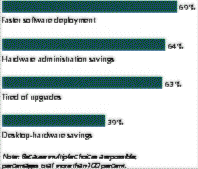
In this section, I’ll provide some assumptions and research that might help you reprioritize or reallocate your budget. Although performance issues as well as the central management of hardware and software are good reasons for deploying the thin-client/server model within your environment, it’s the cost considerations that usually drive many IS professionals to look at this alternative. In his “Back to the Future…” editorial in Windows NT Magazine, editorial director Mark Smith states that “Industry analysts estimate that you spend more than $10,000 per year to maintain the PC you bought for $2500.” In fact, comparing the setup costs of 15 thin-client Windows-based terminals to 15 PCs, the Zona Research Group calculated a 54 to 57 percent savings by using terminals. With results like this, Smith estimates that as many as 50 percent of all desktop workstations, depending on the needs of the users, could just as well be thin-client workstations.
Performance, central management, and cost-effectiveness drive movement to thin-client/server solutions.
Research commissioned by Citrix found that in addition to saving costs, IS managers’ greatest concern was the need for rapid deployment of applications. (See Figure 6-1.) Thin-client/server computing provides IS professionals with a solution that allows them to reallocate and optimize computing infrastructure and human resources.
FIGURE 6-1
What’s important to thin-client planners?

The following sections will look at some considerations for the capacity-planning phase of a thin-client/server rollout of WinFrame with respect to network access and bandwidth as well as hardware and software issues. Some of the efficiencies in deploying human resources to support the computing environment will also be discussed.